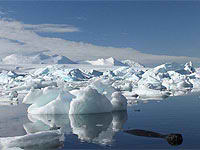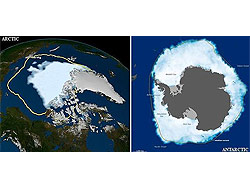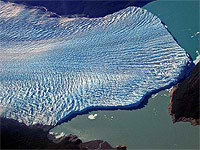Un trozo de hielo extraído de territorio antártico reveló trazas de uranio, las que precipitaron por circulación atmosférica sobre el continente en 1995 provenientes de Australia, informó el glaciólogo chileno Ricardo Jaña al diario El Mercurio del domingo.
"Haciendo un número grande de mediciones en cantidades tan pequeñas se logró detectar la presencia de trazas de uranio que, de acuerdo con el nivel en que se encuentran, coincide con un año (1995) cuando en Australia aumentó la producción de uranio", dijo Jaña, geofísico del Instituto Antártico Chileno (INACh).
La hipótesis plantea que el material particulado generado por esa actividad minera fue arrastrado por el viento y siguió la trayectoria de la circulación atmosférica similar al sentido de las manecillas del reloj hasta precipitar a la meseta Detroit (norte de la península antártica), publica el periódico.
Los estudios, que comenzaron a fines de 2007, pertenecen al proyecto "CASA, Clima de Antártica y Sudamérica" que realizan investigadores del Instituto de Cambio Climático de la Universiad de Maine (EEUU); de la Universidad Rio Grande do Sul (Brasil), y del INACh.
"La evidencia científica de los testigos de hielo (trozo de hielo en forma cilíndrica) es contundente y es informativa en cuanto a una serie de fenómenos relacionados con la dinámica del clima", sostuvo Jaña.
Noticia publicada en Univisión (EEUU)
Enlaces a sitios |
| |
Climbing Magazine Climbing Magazine"s Web site contains more than 30 years of rock and ice climbing news, climber profiles, technical information, and gear reviews. You"ll also find message boards, photo galleries, and classifieds
| Cold Regions Bibliography Between 1999 and 2000, this project was carried out under an Interagency Agreement between the Federal Research Division of the Library of Congress and the U.S. Army Cold Regions Research and Engineering Laboratory (CRREL).
|
Descent into the Ice A tem of "glacionauts" ventures into a labyrinth of unexplored anda hazardous glacier caves on France"s Mont Blanc
| Glacier and Permafrost Hazards in Mountains – GAPHAZ Scientific Working Group of the International Association of Cryospheric Sciences (IACS) and the International Permafrost Association (IPA). Department of Geosciences University of Oslo
|
Glacier hazards The experience and data on glacier disasters in Switzerland has been systematically collected in the past two decades, and historical sources were analyzed.
| Glacier Hazards From Space Glacier hazards represent a continuous threat to human lives and infrastructure in mountain regions.
|
Glacier Hazards in Perú The floods, known in Perú as aluviónes, come with little or no warning and are composed of liquid mud that generally transports large rock boulders and blocks of ice.
| Glaciers and Glacier Hazards Glaciers and Glacier Hazards Glaciers and Ice Sheets and Volcanic Eruptions, USGS/Cascades Volcano Observatory, Vancouver, Washington
|
Glaciers online Glaciers online offers photos and summary explanations concerning glaciers from all over the world. The primary goal of our project is to enrich and stimulate the teaching of Earth Science and Physical Geography, in particular glaciology.. Jürg Alean & Mi
| Global Land Ice Measurements from Space GLIMS (Global Land Ice Measurements from Space) is a project designed to monitor the world"s glaciers primarily using data from optical satellite instruments, such as ASTER (Advanced Spaceborne Thermal Emission and reflection Radiometer).
|











 Imagen: Agencia Reuters
Imagen: Agencia Reuters





